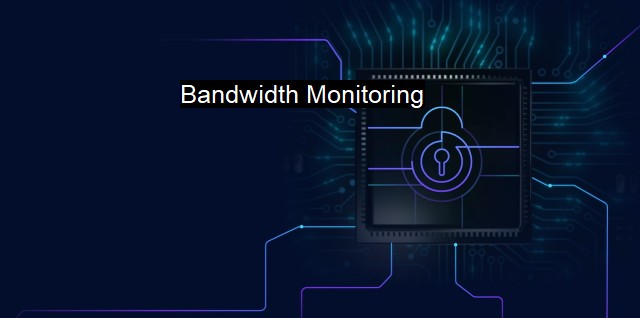What is Bandwidth Monitoring?
The Importance of Bandwidth Monitoring for Network Security: Analyzing Data Usage and Guarding against Cyber Attacks
Bandwidth monitoring refers to the process of measuring the amount of data transferred over a computer network in a given period. It involves quantifying the data flow in terms of quantity ('bits'), duration ('seconds'), or both. the relevance of bandwidth monitoring cannot be overstated. It functions as a critical tool that aids in identifying unusual or suspicious activities on a network, often serving as the first line of defense against potential cyber threats and attacks.In the ever-evolving landscape of cybersecurity, malicious entities continually devise innovative ways to damage, disrupt, or gain unauthorized access to networks, systems, or information. For instance, a simple, overtly harmless browsing activity can escalate to a threat, such as a Distributed Denial of Service (DDoS) botnet attack targeting the bandwidth space. By continuously keeping tabs on the transiting data volume, bandwidth monitoring provides pivotal information for identifying any inconsistencies, thus enhancing the overall security of the network.
To better understand where potential threats may lie, real-time and historical bandwidth usage data are collected and analyzed to develop baseline behavioral patterns. In light of these patterns, cybersecurity professionals can distinguish between regular bandwidth consumption and abnormal surges in flow. an abrupt increase in data transfer — particularly involving data being sent out of the network — may signal a data breach or malware's presence, prompting further investigation.
Cybersecurity experts usually put antivirus systems in place to safeguard computer networks from multiple threats, especially malignant software like viruses, worms, spyware, ransomware, etc. even these protective measures might not be able to defend against all manner of cyber exploits, particularly advanced persistent threats persistent on infiltrating over long periods. This is where the capabilities of bandwidth monitoring come into play to support these security systems by acting as an additional layer of defense.
There are numerous scenarios where internet bandwidth monitoring helps in enhancing cybersecurity and boosting antivirus defenses. One key instance is managing spam email attacks. Usually, these attacks escalate when a user interacts with an adverse email, which then triggers multicast spam emails forwarding to each contact recorded on the host’s email account. In such circumstances, bandwidth monitoring can pick up on the unusual outflow of data and raise an alarm, helping to nip any potent cybersecurity threats in the bud.
Monitoring the bandwidth also allows other computing resources' optimization. Excessive bandwidth usage impedes the network's performance speed, and prolonged high use can also hint at either an erroneous configuration or a developing cyber threat. Recognizing such trends through the bandwidth usage aids in troubleshooting the problematic areas and proactively realigning the settings for optimal operations.
Modern cybersecurity frameworks across businesses and enterprise networks utilize various analytical software to monitor bandwidth usage continually. These tools grant a granular visibility over minute-by-minute data activities, thereby allowing close vigilance over the entire networked ecosystem. application-level bandwidth monitoring is becoming more prevalent recently, as it allows more precise control and in-depth analysis at an application level, spot potential problematic apps, and severe the link before they can lead to potential losses.
In the digital era, where cyber exploits are evolving just as rapidly as the countermeasures, protecting valuable information and resources from potential threats is essential. Bandwidth monitoring has emerged as an invaluable tool that works in tandem with antivirus and other cybersecurity defenses to create a more secure digital network. Through consistent bandwidth management, organizations can identify, respond, and prevent cyber threats while achieving optimal network performance.

Bandwidth Monitoring FAQs
What is bandwidth monitoring in the context of cybersecurity and antivirus?
Bandwidth monitoring in the context of cybersecurity and antivirus refers to the process of monitoring the amount of data that flows through a network's devices and connections to detect any unusual activity. It helps identify potential security threats and virus attacks that may affect network performance and compromise sensitive data.Why is bandwidth monitoring important in cybersecurity and antivirus?
Bandwidth monitoring is crucial in cybersecurity and antivirus as it helps identify malicious activities in a network. Cybercriminals use the network to transmit malware, carry out phishing attacks, and steal sensitive data. By monitoring bandwidth usage, IT security teams can detect unusual traffic patterns, identify infected devices, and take action to prevent further damage.What are the tools used for bandwidth monitoring in cybersecurity and antivirus?
There are various tools available for bandwidth monitoring in cybersecurity and antivirus, including network-based tools like NetFlow, sFlow, and SNMP, as well as packet-capture tools like Wireshark. These tools provide real-time visibility into network traffic and help identify the source and destination of data, the types of applications being used, and the amount of bandwidth consumed by each device.How can bandwidth monitoring improve cybersecurity and antivirus?
By monitoring bandwidth usage, IT security teams can detect and respond to cyber threats in real-time, preventing potential data breaches and network downtime. Bandwidth monitoring also helps identify high-risk areas of the network, such as those with weak passwords or outdated security protocols, allowing security teams to prioritize security efforts and implement preventative measures. Overall, bandwidth monitoring is an essential component of a robust cybersecurity and antivirus strategy.| | A | | | B | | | C | | | D | | | E | | | F | | | G | | | H | | | I | | | J | | | K | | | L | | | M | |
| | N | | | O | | | P | | | Q | | | R | | | S | | | T | | | U | | | V | | | W | | | X | | | Y | | | Z | |
| | 1 | | | 2 | | | 3 | | | 4 | | | 7 | | | 8 | | |||||||